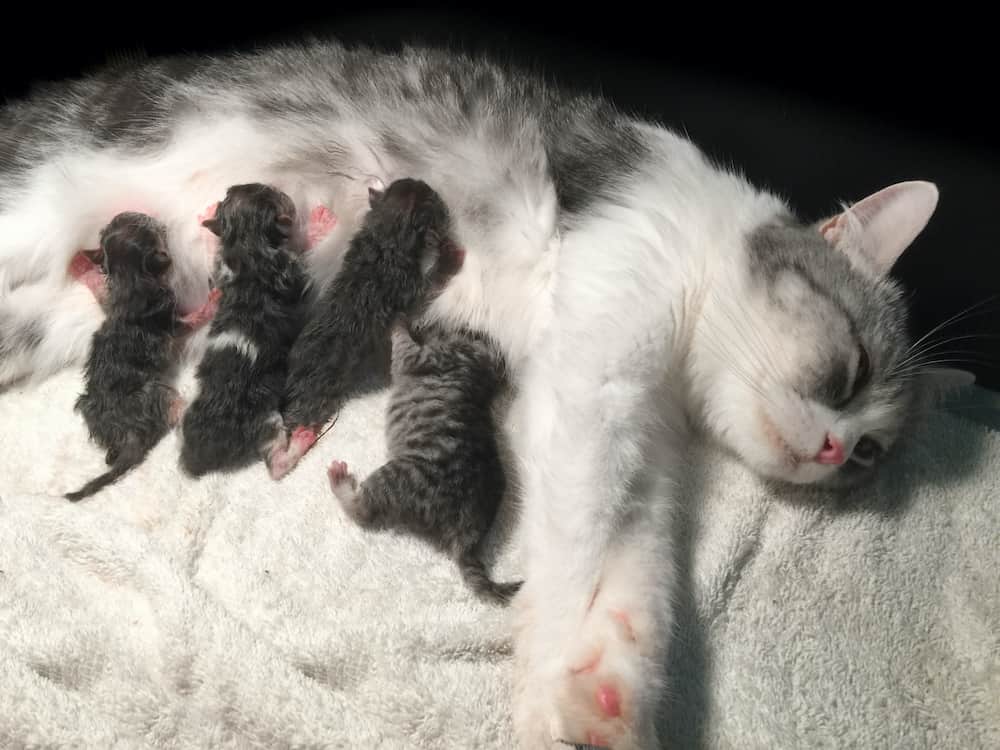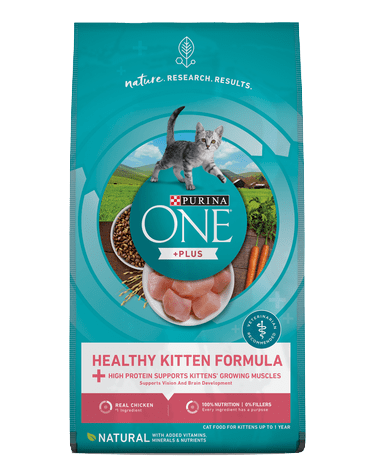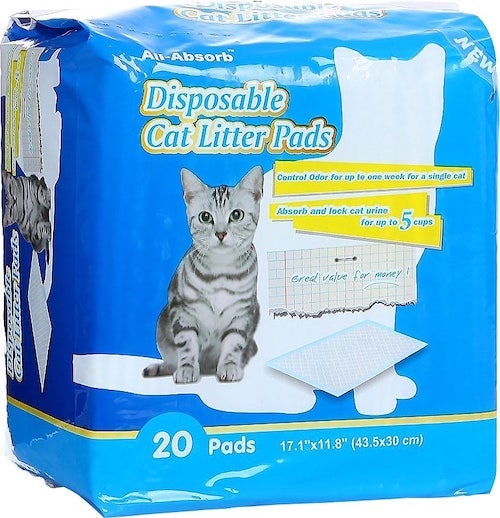
Cat Pregnancy Calculator
Estimate when your cat is due to give birth by entering the date of the first mating below and stay prepared for additions of new kittens to your family!Protect your beloved pets without breaking the bank
- Unlimited video calls & texts with vets
- Available 24/7
- Annual $3,000 emergency fund
- LIMITED TIME - 7 DAYS FREE trial
- SPECIAL OFFER - 20% OFF 1st month
Code: GOODY20
- Flexible coverage
- Hassle free claims
- Multiple pets family plan
How Long Are Cats Pregnant?
Your cat is having kittens and you don't know what to do. The thought of having a bunch of little fur babies running around the place is exciting. However, the dread of not knowing what to expect and what to do for your cat is even more overwhelming.
Well, you have come to the right place. In the sections below, we shall take a look at everything you need to know about a cat's pregnancy from when and how it happens to exactly how to take care of them even after delivery.
The average gestation period for a cat is 58 to 67 days which translates to 8 to 10 weeks.
There are also cases where the pregnancy may exceed this range up to 72 days but this is a very rare occurrence. Because the pregnancy is just a little over 2 month, there is no trimester system used to divide the stages. Instead, there are 5, loosely defined stages that we will take a look at shortly. Let's get right into it.
Feline Estrus stage
What to expect
Technically speaking, this is not necessarily a stage of pregnancy in cats. However, it is very crucial to the entire process and thus deserves a spot on this cat pregnancy care guideline. It is actually widely regarded as the first stage of pregnancy in cats which shows how important it is.
This is also known as the heat cycle and prepares the cat's reproductive system for mating, ovulation, and pregnancy. This heat cycle starts at around 7 months in most cats but could appear as early as 5 months of age.
The length and interval of a female cat's heat cycle varies with breed and the cat's individual status. On average, it will last 7 days and terminate when ovulation occurs. However, it could last as long as 19 days especially with outdoor cats exposed to male cats.
As the cat owner or a foster parent, here are some of the signs you should look out for to tell when your fur baby is on heat.
- Increased vocalizing
- Restlessness
- Increased affectionateness
- Increased desire and efforts to go outside
- Increased head butting
- Rolling on the floor
More often than not, these signs are behavioral. However, there are also physical changes that are usually picked up by experts. These include a slightly swollen vulva with small amounts of clear discharge.
How to care for the cat
When your cat is one heat, all you can do is ensure that they are comfortable as they ride the uncomfortable wave of hormones and emotions. Make sure that they have somewhere cozy to rest and that they have enough food and water.
You should also do your best to keep them as far away from male cats as possible. This helps prevent unwanted pregnancies and potential risks especially to younger female cats.
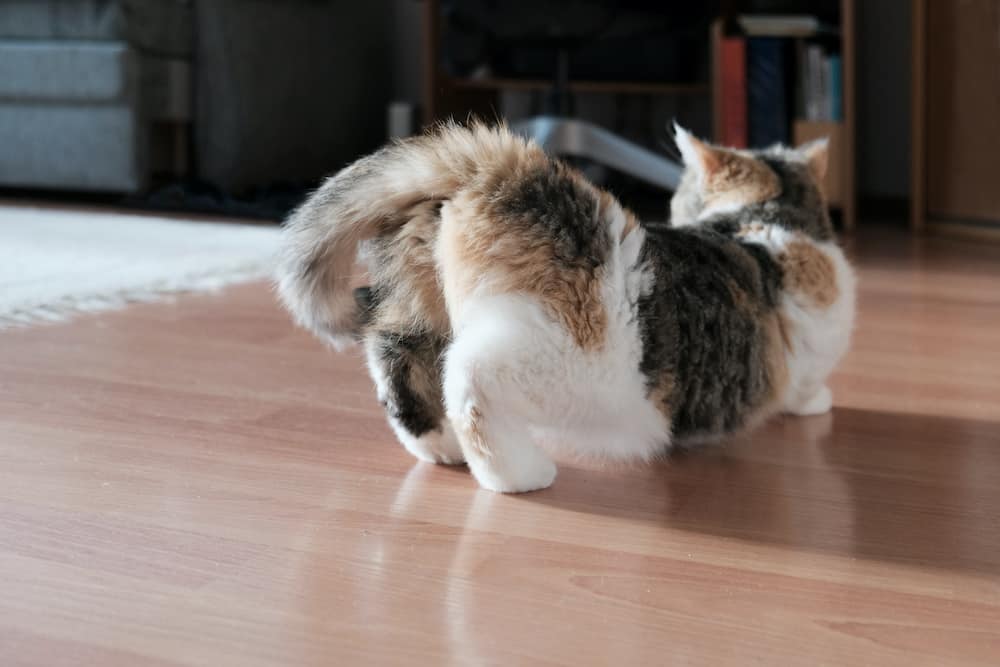
Week 1 - Day 0 to 7
What to expect
Week 1 marks the start of the second stage and begins when fertilization occurs. This happens 20 to 24 hours after copulation with a male cat with the sperm and ovum fusing to form a zygote.
Over the week, the cells make their way towards the uterus while undergoing continuous division into a mass of cells. By day 5 after fertilization, the mass of dividing cells should have reached the horns of the uterus.
During this stage, there are no changes to pick up on in the mother cat. You therefore might not even be aware that it is happening at all.
How to take care of the cat
There is not really much to do in terms of intentional changes in care practices as this stage usually passes you by without even noticing it. All you can do is continue feeding your cat, keep them hydrated, and ensure that they are loved and as comfortable as they can be.
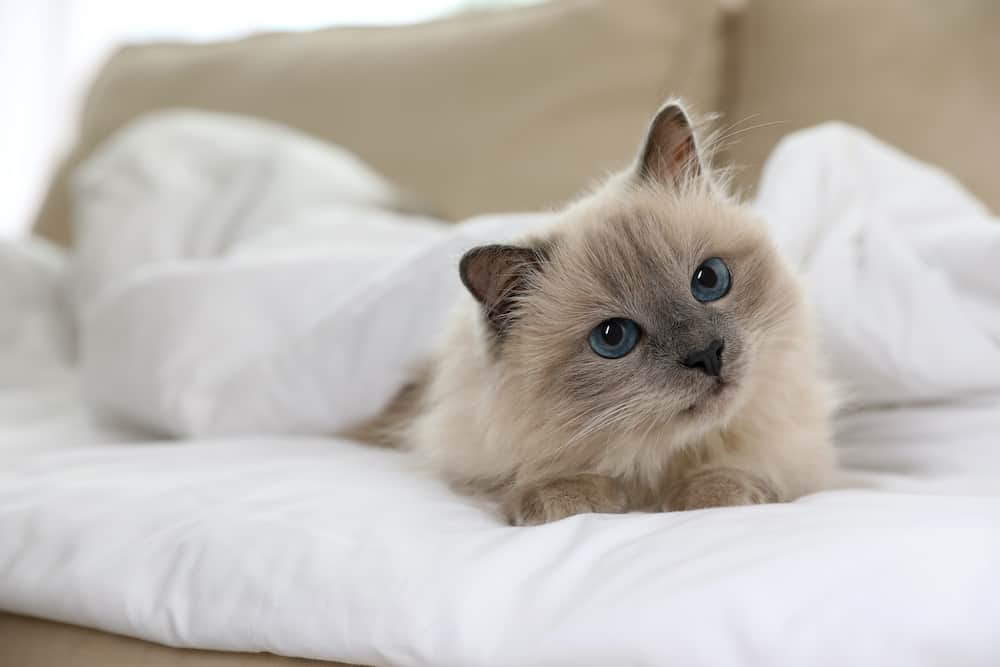
Week 2 - Day 8 to 14
What to expect
Upon reaching the uterus, the ball of cell splits into blastocysts that later on develop into the individual kittens. By day 12 or 13 of the pregnancy, these blastocysts implant onto the mother cat's uterine lining.
As with the first week of the cat's pregnancy, this is a relatively quiet week with no visible signs in the pregnant kitty. However, by the end of this week, a professional in the veterinary field or a breeding expert may be able to palpate abdominal masses about 1 cm wide.
How to take care of the cat
The cat's needs are still quite low during this week as there is not much going on in terms of growth and development. As such, your only job is to keep the cat comfortable, well-fed, and hydrated.
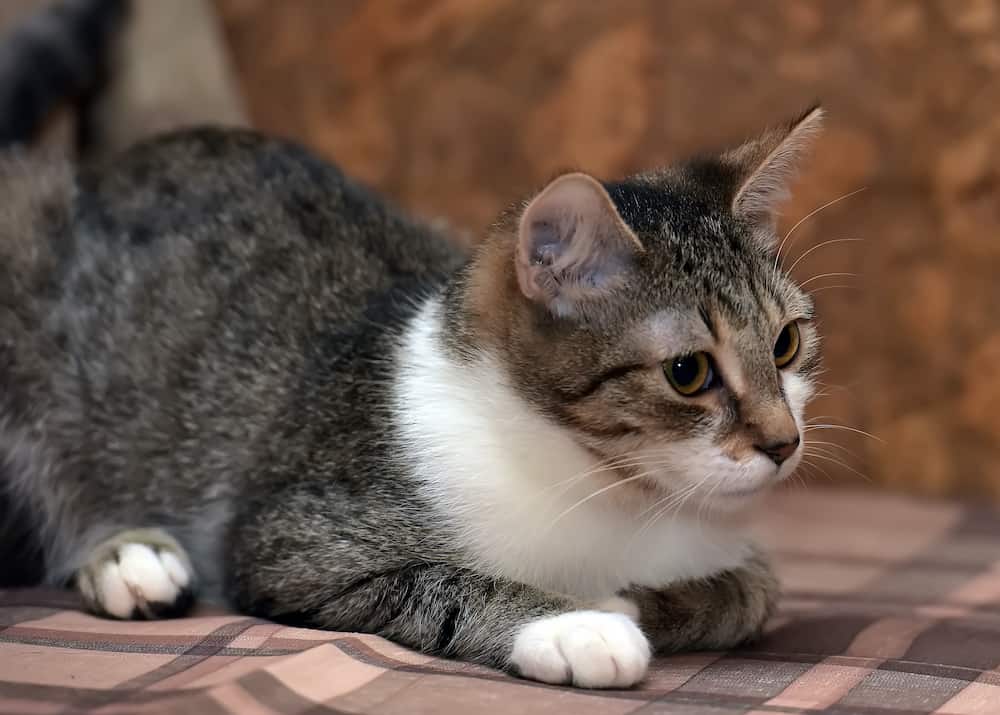
Week 3 - Day 15 to 21
What to expect
Week 3 of the cat's gestation is a bit more exciting in terms of events within the uterus. By the 15th day, the placenta is usually formed and fully functional. The fetus begins specific development of organs including limbs but is still very far from its final kitten form.
The 21st day marks the transition of the cell masses into embryos.
These are actually visible on ultrasound as C shaped masses. They are also palpable through the abdominal wall and can be felt as 2 to 3 cm masses.
At this time in the pregnancy, hormonal changes also start to take effect and you may observe some changes in personality. The cat may either be very affectionate or unusually distant.
How to take care of the cat
This is yet another very hands-off stage in your beloved pet's pregnancy. Just figure out their mood and adapt as necessary. If the cat is being distant then give it space. If it is being very affectionate then indulge them with cuddles and petting.
You should also continue with the same feeding schedule to support their health and the development of the little embryos. Finally, you also have the option to have a vet visit for an initial assessment of the health and safety status for the mother and their unborn kittens.
Week 4 - Day 22 to 28
What to expect
At this stage, the embryos are considered fetuses and it will remain that way until they are delivered.
This is where things start to get a bit more interesting in the cat's pregnancy. Within the uterus, the kittens are growing at a rapid rate and have started to develop organs. These include limbs and eyes as they start to resemble actual kittens.
It is also during this week that you start to see some physical and more pronounced behavioral changes that indicate pregnancy. The physical signs are as a result of both hormones and the growth of the fetuses within the uterus. However, it is still quite early in the pregnancy so the changes may not be very obvious. They include:
- Subtle weight gain
- Widening abdominal girth
- Increased intensity of morning sickness
- Nipples start to turn a deep pink or red
On the other hand, the behavioral changes that started in the 4th week may intensify. The list also expands to include changes in appetite and activity levels with the cat eating more and playing much less than they do normally.
How to take care of the cat
It is still a little too early to change the diet in terms of constituents and portions. Therefore, just continue with the same portions and meal times you were using before. You should also consult your vet about whether the cat needs deworming at this stage of the pregnancy or not.
Week 5 - Day 29 to 35
What to expect
This week is marked by continued growth with kittens reaching a length of 5.8 to 6 cm by the 35th day. They are also continuing to develop and actually have very distinct paw pads by the end of this gestation week.
As far as the symptoms in the mother cat go, there is nothing new to expect here other than an increase in intensity of those that appeared in the 4th week. The nipples may also start to look a little swollen.
How to take care of the cat
Being smack in the middle of the pregnancy, this is another great time to consider visiting the vet for a status assessment for the pregnant cat and the fetuses.
You should also start increasing the portions of food to match the spiking demand from the growing kittens.
Here, your vet would be in the best position to tell you by how much to increase the meal portions depending on the cat's specific needs.
Finally, try and minimize your handling of the cat as much as possible during this time especially lifting. It is not only very uncomfortable for them but may also potentially cause harm to the unborn kittens.
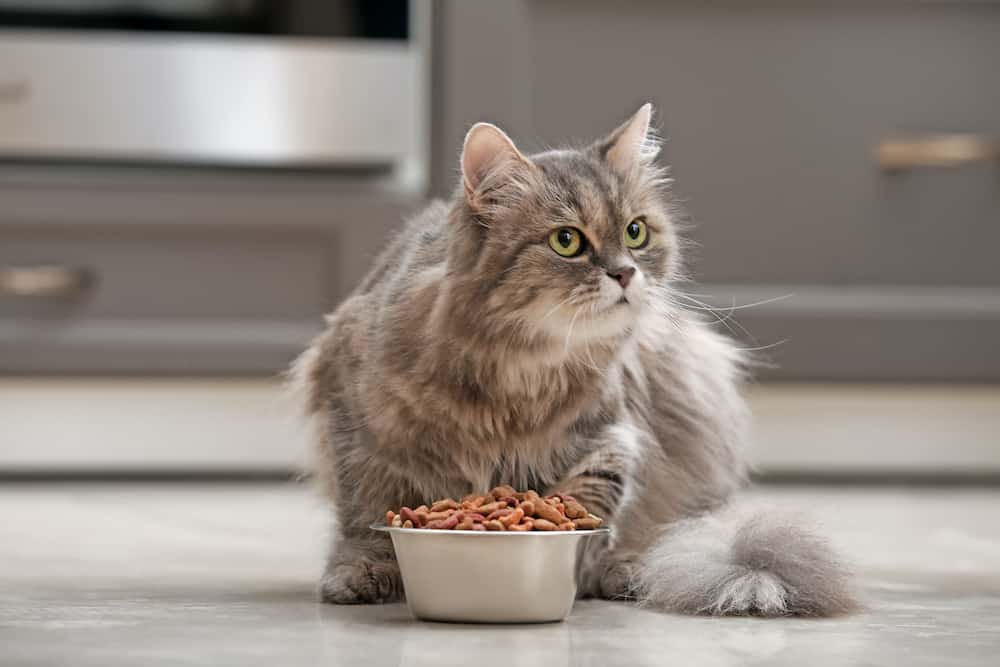
Week 6 and 7 - Day 36 to 49
What to expect
These two weeks are rapid growth weeks. Things go so fast that the changes pretty much morph into one another to form what is considered the beginning of the third stage of the cat's pregnancy.
By day 40 to 45, the bones in the fetuses are mineralized. X-ray imaging can therefore be done to determine things like the number and position of the little ones in the uterus.
The changes on the cat are more obvious as the abdomen continues to enlarge. This may get to a point it affects their movement and reflexes leaving them slaw and awkward. The pressure on their stomachs also makes them eat smaller portions as they get full quite fast.
How to take care of the cat
While your cat may get full quickly during these weeks, their calorie needs are higher than ever. The best thing to do is adopt a new meal schedule with smaller portions in higher intervals.
You should also consider feeding the pregnant cat some kitten food in addition to the regular cat food. These meals are often formulated for pregnant and lactating cats as well as for their kittens to meet the very specific demands.
We recommend you try out Purina ONE Healthy Kitten Dry & Wet Kitten Food whose high quality ingredients and balanced nature are exactly what the cat needs.
Another small gesture that will make all the difference for your cat during this time is to make all their basic needs easily accessible. Consider moving their food and water bowls as well as their litter box to the room they spend the most time in.
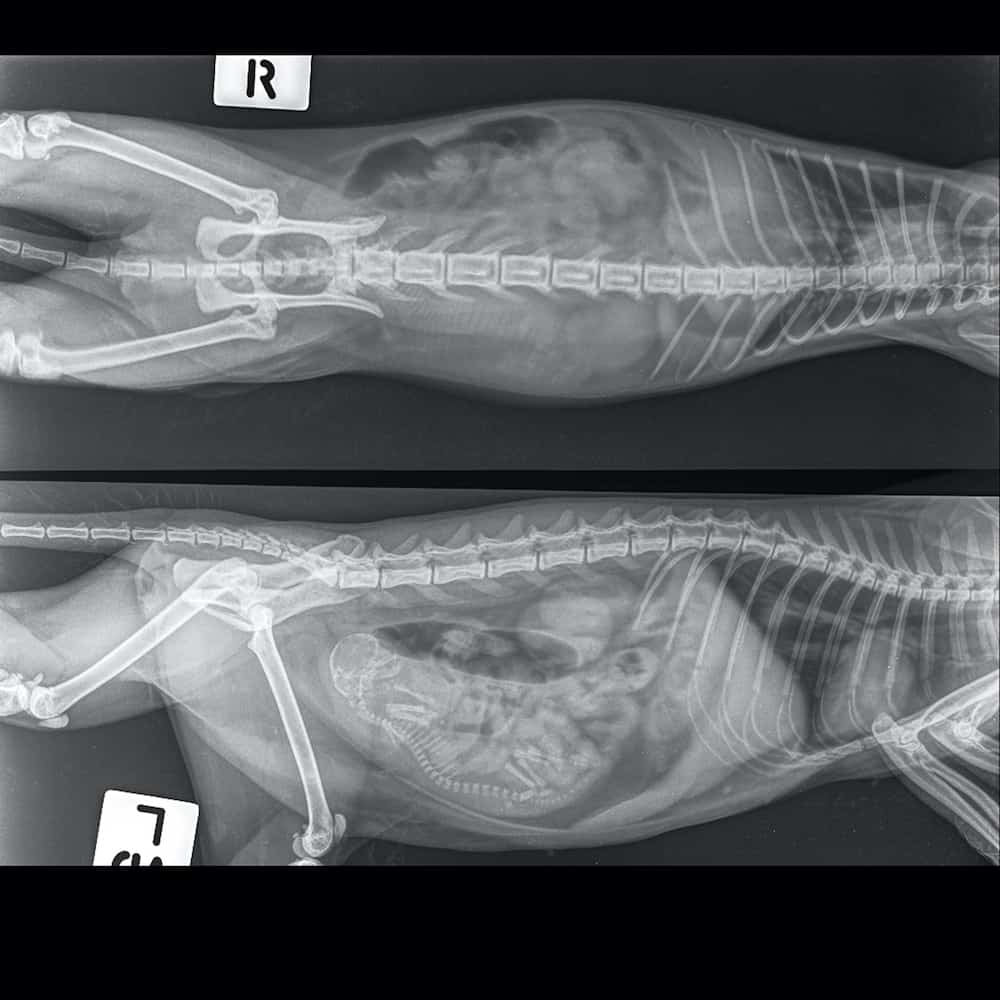
Week 8 - Day 50 to 56
What to expect
By this week in the pregnancy, the kittens are just about ready to come out. They measure approximately 3 inches by day 50 and up to 5 inches by day 56. They also have a thin layer of fur covering their skin. There are cases where the cat goes into labor and delivers during this week. However, this is not only uncommon but could be dangerous to the kittens that need just a bit more time before they are ready for the world.
On the surface, it is very obvious that the cat is about ready to give birth. You may notice the little fetuses protruding and moving around beneath the surface of the abdomen. The cat also experiences some fur loss on the lower abdomen which usually grows back a few weeks after delivery.
Finally, with the weight of the full uterus on the bladder as well as the cat's limited mobility, potty accidents are very common during this week.
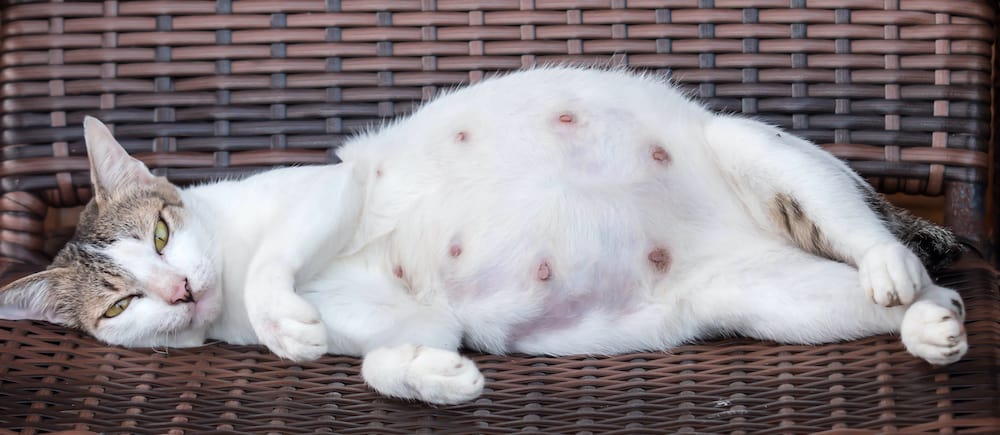
How to take care of the cat
First off, continue with the spaced meal plans and increase calorie supply to support both the cat and the fetuses.
You also want to keep her as comfortable as possible in which case you should invest in a cozy cat bed if you don't already have one. Alternatively, you could make something using cushions or soft cloths and the cat will appreciate it just as much.
Speaking of comfort, cats are very fussy about their hygiene and the pregnant fur ball will definitely not be comfortable hanging out in filth. You could thus invest in potty pads that soak up the urine and make clean up easy if they have potty accidents.
For this, we recommend you try All-Absorb disposable litter pads. They are super absorbent and waterproof on the base side to prevent soiling the cat's bed or nesting space.
Week 9 and 10 - Day 57 onwards
What to expect
Week 9 and 10 mark the end of the journey and are the two most sensitive weeks. By day 60, the kittens are usually about 13 cm. In-utero development is also complete and the kittens have a very high chance of surviving if they are born at this time.
The mother's belly is largest at this point. It may be so uncomfortable they are not able to properly groom themselves. In most cats, this is also where milk dropping occurs and this signals that labor will start in a few hours to a day or two.
Signs of labor are subtle at fast but intensify as the cat gets closer to queening. They may start off being very reserved and will try to hide from you. They also get very vocal meowing and purring loudly as the contractions come and go. Here are a few more signs to look out for that show a pregnant cat is going into labor. Reduced appetite
- Restlessness and pacing
- Milk production by enlarged mammary glands
- Drop in body temperature
- Nesting behavior
- Licking their abdomen and vulva if they can reach
How to take care of the cat
Your job during these weeks is mainly to help find the cat a comfortable nesting spot. Sometimes they will disregard what you have prepared for them and just find another spot they find safer and more convenient. In this case, all you can do is restrict access to rooms you don't want the cat to establish the nest in.
In addition to keeping them well fed, hydrated and comfortable, you also have to keep an eye out for danger signs in the 4th stage of pregnancy. These include:
- Prolonged contractions lasting more than one hour.
- Prolonged labor lasting more than 21 hours.
- Foul-smelling discharge.
- Fever.
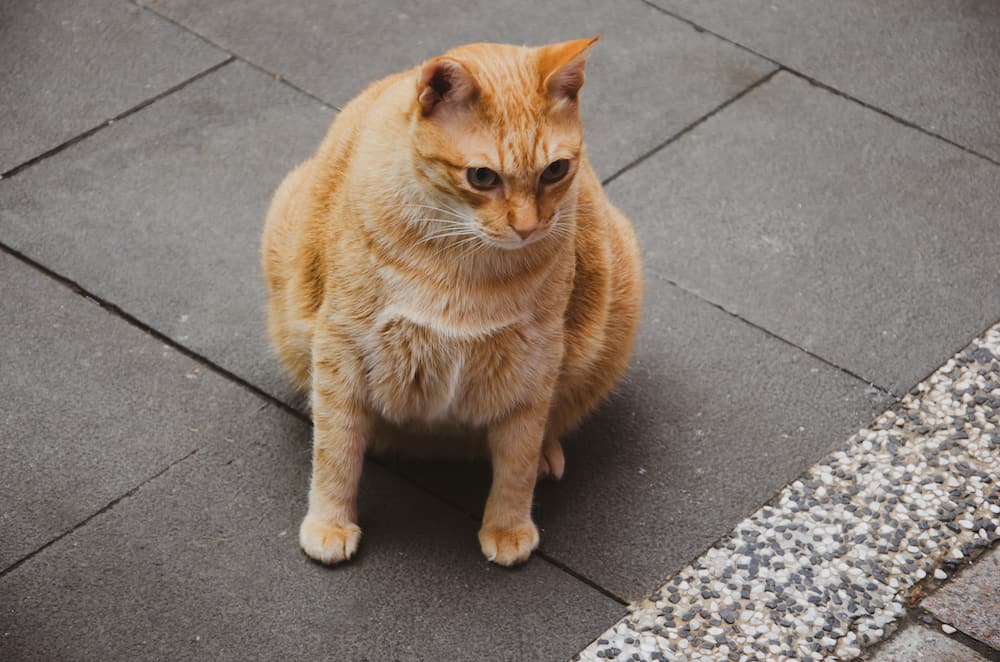
Queening
What to expect and how to care for the cat
Queening is the process of delivering the kittens and pregnancy membranes including the placenta. This is a critical time for both the cat and her kittens. For the most part, healthy cats can handle the entire process on their own. All you have to do is watch out for any signs of complications.
The delivery itself happens in 3 stages. Here is more about what happens in each and what you can do to help if anything.
Stage 1
This starts when the cervix softens and dilates in preparation for the passage of the kittens.
It should take 1 to 2 hours and if it lasts any longer you need to consult a vet immediately. You will not be able to actually see the cervix dilating.
However, you will notice the cat getting restless, taking more potty breaks, and vocalizing in closer intervals showing closer contractions.
Your job here is to just give her space and monitor for complications.
Stage 2
This stage starts when the first kitten passes the pelvic canal. At the level of the vulval opening, you will see the sac with the kitten protruding before the entire kitten is expelled. The mother will lick this membrane off them which also stimulates the kitten's breathing.
In some cases, breastfeeding starts immediately. In others, the cat will wait for all the kittens to be delivered before allowing those already out to start feeding.
In total, this stage takes about 15 to 30 minutes in uncomplicated cases. This depends on the litter size with larger litters requiring more time.
Stage 3
This stage is marked by the passing of the placenta. This happens with every delivered kitten and repeats until all the kittens and their placentas are expelled from the uterus.
It is important that you monitor this and keep a record of how many placentas were removed compared to the number of kittens delivered. This is because retention of placentas could cause excessive bleeding, infections, or even death to the cat.
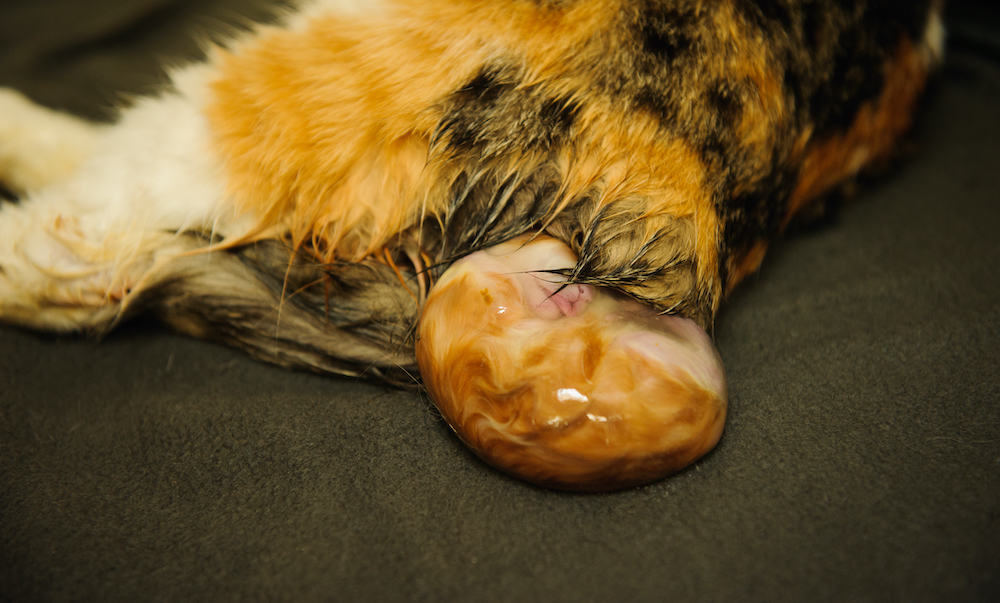
Postpartum period
What to expect and how to take care of the cats
This starts as soon as the last kitten and their placenta are delivered and lasts about 1 to 2 weeks after. Here, you are looking out not only for the cat but for the new, little fur balls also in your care. Here is a brief summary of what is expected of you in this stage.
Mother
After delivery, clear discharge from the vulva is expected. They should be kept comfortable and well fed as they breastfeed and take care of their little kitties.
Increase their portions to about 2 to 3 times to help them produce more milk especially if they gave birth to many kittens.
Also look out for signs of complications including smelly discharge that indicates infection, signs of inflamed mammary glands, and continuous bleeding.
Finally, consider getting the cat neutered in order to prevent unwanted pregnancies in future. In this case, consult a vet for information on the best time to do this.
Kittens
The mother does most of the work when it comes to taking care of the newborns. All you can do is ensure that they are breastfeeding and provide them with a safe, warm place to sleep as they grow bigger and stronger.
